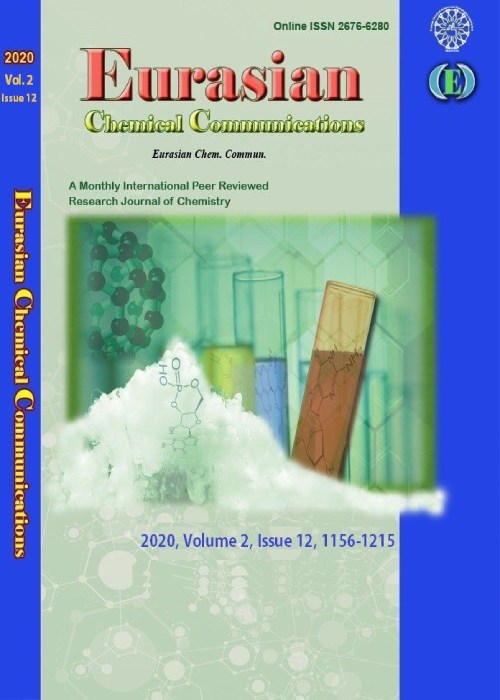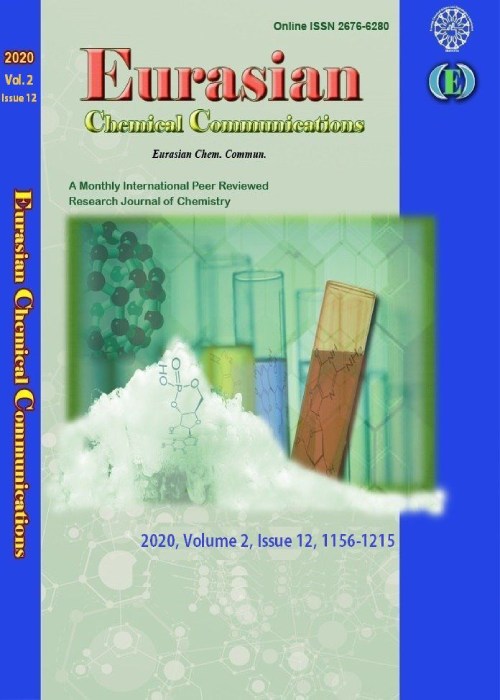فهرست مطالب

Eurasian Chemical Communications
Volume:5 Issue: 11, Nov 2023
- تاریخ انتشار: 1402/08/10
- تعداد عناوین: 7
-
-
Pages 987-999The interest in the role of tonsils and tonsillar disorders in a variety of immunological adaptations have been increased, but their precise systemic immunological roles are not well-established. Samples obtained from 38 patients with palatine tonsillar hypertrophy (Group I, which was further classified into Group Ia including 16 patients with tonsillar hypertrophy without recurrent tonsillitis, and Group Ib including 22 patients with recurrent tonsillitis). Group II included 38 samples of apparently healthy controls were studied. The levels of ASOT, IL-10, and lactoferrin in venous samples were measured, in addition to histopathological examination and immunohistochemical assessment of the CD3 and CD20 expression on the excised samples. The serum level of ASOT among group Ib candidates were significantly higher than that in group Ia and group II. Furthermore, ASOT level showed significantly higher readings in group Ia than in group II. In addition, when comparing group Ia to group II, there was no statistically significant distinction in the levels of IL-10. In contrast, group Ib showed statistically higher levels of IL-10 than group Ia and group II. The group Ia demonstrated no significant statistical difference regarding the lactoferrin levels when compared with group II and statistically significant lower levels of lactoferrin in group Ib was seen when compared to group Ia and II. Recurrent tonsillitis of the hypertrophied tonsils has stronger effects on the systemic immune components than isolated hypertrophy. Further research and analysis are needed to determine the specific nature and individual variances of these influences.Keywords: immune system, immunohistochemistry, interleukin 10, Lactoferrin, Recurrent tonsillitis, Palatine tonsils
-
Synthesis and gas chromatography based characterisation of biodiesel prepared from waste soybean oilPages 1000-1012Petroleum resources are limited on a global scale. Due to non-renewability, these fossil-fuels are projected to be depleted in next 40-60 years if consumption continues at the current pace. Moreover, the price instability of crude oil poses a significant threat to nations with constrained financial and economic resources. To address these challenges, alternative energy sources are being explored, and there is ongoing emphasis on further progress in these areas. As an alternative fuel, biodiesel can be used in neat form or mixed with petroleum-based diesel. Therefore, we need to move towards alternative fuel like bio-diesel. Several alternative fuels have been studies among which biodiesel from waste soybean oil having great importance. Bio-diesel could be easily prepared from waste soybean oil, by the process of transesterification with alcohol in presence of sodium hydroxide or potassium hydroxide. India is the fourth largest producer of soybean in the world, and from last few decades, soybean oil is exclusively use as edible oil. In different food industries, several million tonnes of soybean oil uses every year. Therefore, huge amount of waste soybean oil is produced every year. In the present work, we attempt to synthesize biodiesel using waste soybean oil via transesterification, and characterize by physical, chemical, and spectroscopic instruments, and found the characteristics properties of this biodiesel is quite similar to petroleum diesel . Therefore, this synthesis may use biodiesel as an alternative for petroleum diesel.Keywords: Waste soybean cooking oil, Transesterification, Biodiesel, alternate fuel
-
Pages 1013-1022This method was based on the use of the diazotization method, as a simple, sensitive method, and easy spectrophotometric way, for the determination of Mogadon drug or called Nitrazepam (NZP) in pharmaceutical tablets. This way depends upon the reduction of the nitro to amino group; reacts with reagent catechol to form a color complex with the best maximum absorption at 463 nm. The optimal conditions were studied for an experiment such as effect of base volume, effect of kind and acid volume, contact time, and temperature. The spectrophotometric way has been successfully useful to determine NZP in pharmaceutical tablets. The best absorbance as optimal volume NaOH at 1 mL and 1 mL HCl. Optimal time required to complete the azo coupling reaction was found to be 3 min for NZP drug. Where the range concentration 1-20 mg/10 mL, it obeys Lambert Beer Law Correlation coefficient (R2 =0.9982). The selectivity of the suggested was reveals the influence of number of some materials foreign (like lactose, starch, glucose, dextrose). The data show that the examined interferences non-overlap with suggested method. The recovery of NZP drug in tablets was in the range of (96% -100.1 %). The statistical result compared with these found by a way reported in literature. This simple, sensitive, and selective, method can be utilized to do control analysis for drug determination.Keywords: spectrophotometric, Pharmaceutical, Diazotization method, Nitrazepam, Catechol
-
Pages 1023-1037In this study, removal of three toxic chemical pollutants, such as crystal violet (CV) dye, tetracycline (TC) drug, and phenol (PH) using sodium alginate-g-poly (acrylicacid-co-sodium, 4-ethenylbenzenesulfonate, hydrate)/Zinc oxide, and SA-g-poly(AC-co-EBS)/ZnO hydrogel composite was prepared by co-polymerization method by addition of free radicals. The hydrogel composite was characterized by TEM, FESEM, and XRD. Removal of laboratory sample aqueous pollutants (dyes, drugs, and phenol) using hydrogel composite to give low absorbance (0.0001) utilizing UV-Vis spectrophotometer for at a chosen wavelength for 2 h. Comparative between ((SA-g-(PAAc-co-EBS)/ZnO, (SA-g-(PAAc-co-EBS), and ZnO NPs) surfaces as adsorbents. The best results of the percentage of removal (E%) of three pollutants arrange in order increasing (SA-g-(PAAC-co-EBS)/ZnO NPs > SA-g-(PAAC-co-EBS) > ZnO NPs), the good results of the percentage removal (E%) of hydrogel composite, (92, 451%, 87.56%, and 82.56%) for CV, TC, and PH, respectively. Likewise, comparative between the amount of Zinc oxide nanoparticles (ZnO NPs) decorated of (SA-g-(PAAC-co-EBS) using (0.05, 0.08, 0.1, and 0.15 g). The good results of the percentage of removal (E%) of three pollutants about 0.1 g ZnO NPs. Re-cyclability and desorption studies indicated the best re-cycling performance of the prepared composite. Based on the results, the prepared hydrogel composites can be useful as a promising, ecological, cost-effective, and efficient material for dyes decontamination. Studies was carry out using several desorption agents at concentration (0.01 N) like HNO3, NaOH, H3PO4, H2SO4, HCl, and water. The hydrogel composite, was regeneration with 100% can be desorbed in diluted hydrochloric acid (0.01 N). The isotherm Freundlich and Langmuir models are also introduced, it has been found that all results follow the Freundlich model in the presence of three pollutants; this nonlinearity is higher when using the Freundlich model.Keywords: Removal, Hydrogel, Isotherm, Crystal violet dye, tetracycline drug, Phenol
-
Pages 1038-1042
Malignant lymphoma is categorized into Hodgkin's lymphoma (HL) and non-Hodgkin's lymphoma (NHL). Lymphoma, especially NHL, can manifest outside lymph nodes, particularly in the gastrointestinal (GI) tract. Hepatitis C virus (HCV) can induce disruptions in both the liver and other organs, with NHL being the most common extrahepatic manifestation. Secondary Autoimmune Hemolytic Anemia (AIHA) can develop in patients with lymphoproliferative disorders. A 47-year-old man presented with abdominal pain, jaundice, and weight loss. His laboratory examination revealed anemia, (direct and indirect) hyperbilirubinemia, elevated levels of aspartate transaminase (AST), alanine transaminase (ALT), and lactate dehydrogenase (LDH), reactive anti-HCV, and positive HCV RNA. Biopsy results supported a diagnosis of B-cell NHL. In addition, imaging displayed multiple intra-abdominal lymphadenopathies. The patient was diagnosed with colon B-cell NHL primarily based on clinical symptoms and biopsy results. NHL in this patient could be attributed to HCV infection. Furthermore, the AIHA experienced by these patients may result from lymphoproliferative disorders, namely NHL.
Keywords: NHL, Hepatitis C, B-cell NHL, Primary GI lymphoma, AIHA -
Pages 1043-1054One of the critical strategies in developing new drugs is to design drugs through structural modification. The structural modification leads to changes in the structure of a compound, thereby changing the compound''s physicochemical properties, including lipophilic, electronic, and steric properties. These changes will cause changes in the biological activity of the compound. This study aimed to determine the effect of substituents on the benzoyl group of the compound N-benzoyl-N’-naphthylthiourea (BNTU) on the anti-breast cancer activity of HER-2 in silico. Molecular docking of BNTU lead compound and derivatives using Autodock tools software against HER-2 receptors (PDB ID: 3RCD). Compared to lipophilic and steric properties, electronic properties influence the anti-breast cancer activity of HER-2 on BNTU-derived compounds. The binding score (∆G) of BNTU-derived compounds with strong electronic substituents was more negative than lipophilic and steric substituents. However, there is an anomaly in BNTU derivatives with fluoro (F) substituents because they have the lowest anticancer activity compared to the other BNTU derivatives. Anti-breast cancer activity of BNTU-derived compounds is influenced by variations in substituents, especially by the electronic properties (electron withdrawing groups) of these substituents. Compounds with Br substituents have a better affinity for HER-2 receptors than the lead compound BNTU and other BNTU derivatives.Keywords: Structural modification, BNTU, lipophilic properties, Electronic properties, steric properties, In Silico
-
Pages 1072-1081The prevalence of diabetes worldwide is increasing; other infectious diseases, such as obesity-related diseases, include hypertension, heart disease, dyslipidemia, and diabetes mellitus (DM). Physical exercise is known to control blood sugar. This study aims to determine the effect of high-intensity interval training on blood sugar in people with type 2 diabetes mellitus. We conducted a pre and post-test laboratory experiment with 20 participants who underwent HIIT, including outdoor running, treadmill exercises, and exercise bikes, with a 1:3 work-to-rest ratio. Blood sugar levels were assessed before and after the intervention. Our study found a statistically significant decrease in blood sugar levels following the HIIT intervention (p-value = 0.001). These results suggest that high-intensity interval training can effectively lower blood sugar levels in individuals with type 2 diabetes mellitus.Keywords: High-intensity interval training, Blood glucose, Type 2 diabetes mellitus, Exercise, Metabolic Syndrome


